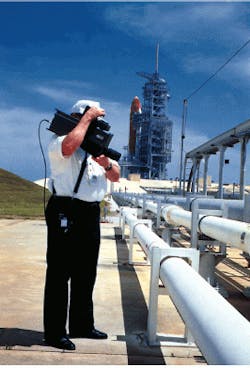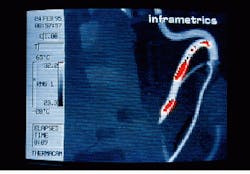Select the appropriate camera for your application
If this year’s SPIE AeroSense meeting held in April in Orlando, FL, is any indication, thermal imaging cameras are becoming more portable and more versatile for field applications, complete with extensive data processing and storage capabilities. Some users need thermal imaging to remotely determine temperature, while others monitor industrial process quality, inspect facilities and assets, and assess energy efficiency of operations and buildings (see Fig. 1). The traditional security and surveillance thermal-imaging markets are also benefiting from system improvements—as well as heightened interest as part of the fallout from the Oklahoma City federal building bombing. Surveillance systems are also seeing increased use for nonintrusive wildlife monitoring. And the maturing of IR-focal-plane array technology has made available cost-effective cameras for businesses that could not afford thermal imaging before, thus widening the current and future market for all players.
Highlighted in this month’s Product Focus are some of the companies and thermal-imaging cameras they produce. The table is not meant to be a complete listing but rather a sampling of the market. A more comprehensive roster of manufacturers and suppliers is found in the 1995 Laser Focus World Buyers Guide, p. 358. Contact each firm for complete product inventories and specification details.
Imaging from heat
Typical infrared detector materials—such as indium antimonide (InSb), mercury cadmium telluride (HgCdTe), indium gallium arsenide (InGaAs), and platinum silicide (PtSi)—are employed in unique ways to produce a thermal image. Mechanical scanning can focus the infrared energy from the camera optics onto a single detector element to form an image from the resulting signal. A linear or two-dimensional (2-D) matrix array of individual elements can be used. Dwell time of an image for the staring 2-D-array detector elements is longer, resulting in a potential sensitivity increase because the elements are not being used to derive more than one pixel of the total image. Scanning-system sensitivity and response time can be boosted with cryogenic cooling systems.
Imaging and thermal measurements are usually done in the mid- and far-IR bands, 3-5 µm and 8-12 µm, respectively, because atmospheric opacity is minimized in these regions. Typical material sensitivities are 2-5 µm for InSb, 3.4-5 µm for PtSi, and, depending on the ratio of HgCd to CdTe, HgCdTe can be used in both IR bands. The near-IR-band, 1-3 µm, is sensed by InGaAs detectors.
Thermal imaging can also be done in the far-IR band using pyroelectric cameras operating on the same principle as laser-beam power and energy meters (see Laser Focus World, June 1995, p. 105) and using the same materials. These materials generate a current proportional to the rate of change of their temperature and thus must employ a mechanical chopper in the optical path. The physics involved require slow panning to scan an object but the cooling needs for pyroelectrics are less than for the other materials, yielding a simpler system.
Of prime consideration in evaluating thermal imaging cameras are image resolution, temperature accuracy, and sensitivity. Resolution is determined by the size of the target object’s image projected on the detector by the camera optics and is expressed in pixels or scan lines. The resulting image is also affected by optics quality and the bandwidth of the detector and electronics.
Thermal inputs to the detector from extraneous sources, including the atmosphere, other objects in the field of view, and the camera`s own electronics, should be accounted for when determining a target`s temperature. In determining temperature for an object whose image does not fill the detector, the detector will average the temperatures of the target and background, inducing higher errors with very small object images. The manufacturer’s camera specifications will list the object-image size versus the averaging-effect error, which, for temperature measurement, should allow readings within 5% of the temperature of a blackbody radiator. The effect of thermal averaging for imaging is not as critical.
Some cameras feature a "field stop" that can be placed into the image plane to prevent undesired radiation from that portion of the field of view from reaching the detector. Temperature readings can also be corrected for an object whose surface emissivity is different from the camera`s calibration value. While seemingly a simple function, temperature measurements often mean high cost decisions, such as changing a design, accepting test results, or removing equipment from service (see Fig. 2).To compensate for unwanted radiation into the detector, some cameras have a built in temperature reference that the detector can "plug into" for self-calibration. Some error remains, however, if the camera is operating at other than calibration temperature and drifts over time from internal heating. Using continuously sampled internal blackbodies can compensate for such error sources for repeatability as well as accuracy.
Sensitivity of thermal imaging cameras is given as noise equivalent temperature difference (NEDT). This is the temperature change of a standard emissivity target that changes the optical signal an amount equal to the detector readout noise (a signal-to-noise ratio of one). Sensitivity, particularly for surveillance cameras, can also be given in terms of minimum resolvable temperature (MRT), the temperature difference needed to resolve a target from the background. With a standard emissivity target this quantity becomes MRDT.
Decreasing detector dark current reduces noise, increasing sensitivity. Cooler detectors can lower dark current for more sensitivity, but cooling complexity leads to larger cameras and servicing and cost considerations. Modern thermoelectrically cooled systems typically run 30,000 h between failures. Stirling coolers may function up to 8000 h before maintenance. And "uncooled" detectors effectively have an unlimited life in this regard.
"No one camera system can satisfy the requirements of every application," notes Elliot Rittenberg of AGEMA Infrared Systems (Secaucus, NJ). "Perhaps the most important task is to carefully define the purpose for which the camera is being acquired," he adds. Included in this assessment are the environment where the camera will be used, distance to the target and its size, the expected temperature range, and any special considerations about the spectral properties of the target. Condition monitoring and maintenance usually mean a portable system with sufficient and convenient data storage. Surveillance requires high spatial and thermal resolution, and process monitoring and control need software and hardware to integrate thermal data with the control system. And all systems need software packages to easily archive, report, and analyze data.
For laboratory R&D work real-time data storage is often needed to capture thermal transients, and data may need to be processed into useful formats. Rapid change of temperature during tests requires a minimum dynamic range that allows sufficient data capture. Interfacing for computer functions not self-contained should be available for image processing needs such as emissivity equalization, real-time subtraction, radiance calculations, temperature time history, and image filtering methods.
Future applications
Traditional thermal imaging such as surveillance and temperature determination have seen continuous system improvements in materials and software, for example. But the advent of lower-cost "uncooled" focal-plane-array technology is not only providing thermal-imaging capability to those organizations that could not afford it before but also permitting new uses entirely. Future applications may include intelligent highway vehicles where thermal imaging can give drivers night-vision capabilities beyond headlight range and aid in collision avoidance sensing.
While military aviation has used forward-looking infrared imaging for night target detection and stealth-fighter navigation, commercial aviation pilots and tower controllers can use similarly functioning systems to increase aircraft safety during landings, takeoffs, and taxiing under reduced visibility or at night. Public safety officials in many more communities could afford to use thermal imaging systems to obtain imaging crucial during emergencies, such as locating fire victims through smoke or fugitives threatening police personnel.
It is certain that future applications of thermal imaging cameras will multiply as users are exposed to the technology and suggest applications not even thought of today.
About the Author
Rick DeMeis
Associate Editor, Technology
Rick DeMeis was Associate Editor, Technology for Laser Focus World from March 1995 through March 1997.

